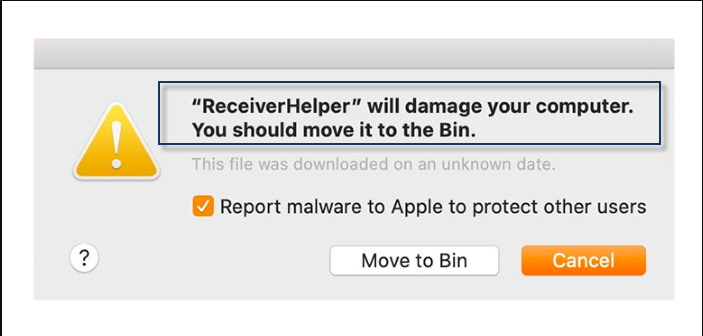ReceiverHelper
ReceiverHelper is a type of junkware that gets installed in Mac web browsers similarly to a regular browser extension. Once inside the system, ReceiverHelper typically changes some of the browser’ settings without needing permission from the user.

Fortunately, the modifications that ReceiverHelper imposes on browsers like Safari, Firefox, Chrome and other popular Mac browsing apps can be reversed and successfully removed. The thing is, this can be done only after the annoying program has been uninstalled. This, however, can often be a challenging task and that’s why in the removal guide below we will show you all the steps that you need to follow in order to accomplish this.
The ReceiverHelper Malware
The ReceiverHelper malware is web traffic-rerouting software that gets installed as an extension in popular browsers. Having the ReceiverHelper malware on your Mac computer can result in a screen filled with page-blocking banners and advertisements that try to trick you into clicking on them.
The main problem with the browser hijackers’ advertisements is that you never know the actual advertising source. This means that some browser hijacker advertisements can be associated with a website or platform that is used to spread viruses and malware such as Trojans, Rootkits and Ransomware.
With this in mind, the full uninstallation of such applications from your Mac system is highly recommended and we encourage you to begin the removal process with the instructions in the guide included on this page.
ReceiverHelper for Mac
ReceiverHelper for Mac is an unwanted program that is categorized as a browser hijacker because it can automatically change browser settings without the permission of the user. Typically ReceiverHelper for Mac can replace the Mac browser’s main search engine and set a new homepage address.
The ultimate goal of these browser alternations is to transform the browser into a tool for online promotion. For instance, the change in the homepage ensures that you are generating automatic traffic to the site that currently is your homepage each time you start your browser. The newly imposed search engine will also probably be set to show you some modified results that favor advertising-paying sites rather than the real sites related to your search query.
The displayed search results may often be accompanied by a stream of pop-up ads, colorful banners, blinking boxes and redirect messages of all shapes and sizes.
ReceiverHelper will damage your computer
“ReceiverHelper will damage your computer” is a Mac-based page-rerouting program designed to earn revenue by displaying pay-per-click ads and sponsored redirect messages. To perform its agenda, “ReceiverHelper will damage your computer” most often relies on auto-redirects and an aggressive exposure to various ads.
Typically, ReceiverHelper is marketed as a useful add-on to your Mac browser, but having it in your system can often be more irritating than useful. For instance, if you try to use your Mac browser to search for something, your screen can get filled with page-blocking banners and hard-to-remove ads that try to make sure you click on them. Aside from being quite annoying, these ads and random links should never be trusted because sometimes clicking on them can lead you to pages full of viruses and notorious threats like spyware, Ransomware, and Trojans.
SUMMARY:
| Name | ReceiverHelper |
| Type | Adware/Browser Hijacker |
| Detection Tool |
Remove ReceiverHelper Malware from Mac
The following instructions will allow you to remove ReceiverHelper in two ways:
- The manual instructions will allow you to remove it on your own by downloading 2 software suites which will show you the folders the threat is located in. Installing, scanning, and deleting everything will require 1-2 hours of your time, depending on your speed and the threat itself.
Note: If ReceiverHelper has an in-built ability to restore itself on a restart, the manual steps will not prevent that. We recommend the automatic removal. - Download SpyHunter for Mac (one of the apps used in the manual instructions), scan with it, and if you decide to use the program, it will likely require about 15-20 minutes. This, however, requires an active subscription for SpyHunter, which means either to use the trial version or purchase the software.
Removal instructions:
1. Download EtreCheck from the Appstore and scan for any ReceiverHelper unsigned files. Delete them. (You can skip this step altogether and download and scan with Spyhunter instead if you don’t want to double-check things).
2. Download and install Spyhunter for Mac. Scan for any malicious files.
3. The app will show you which files are infected. Either use SpyHunter to delete them for you (the automatic removal) or do it manually, which means tracking down each detected location by yourself and deleting the file.
4. In most cases start with /private/var/root/Library/Application Support/.ReceiverHelper/ReceiverHelper
5. In Finder press Shift+Command+G to open the Find window.
6. Search for the /var directory. Then proceed and look for the /root folder inside.
7. It will most likely be locked and you will need additional permissions to meddle with it.
8. Press command+I and scroll to sharing and permissions. Add your user name to permissions.
9. Now you should be able to access the /root folder and proceed and locate the /Library folder inside it. Proceed to do the same until you are inside the /Application Support folder.
10. It is possible that the folder you look for is hidden, if that is the case use command+shift+. to locate and find the file you want to delete.
11. Delete the ReceiverHelper file.
12. If none of this helps, try the steps in this guide.

Leave a Comment